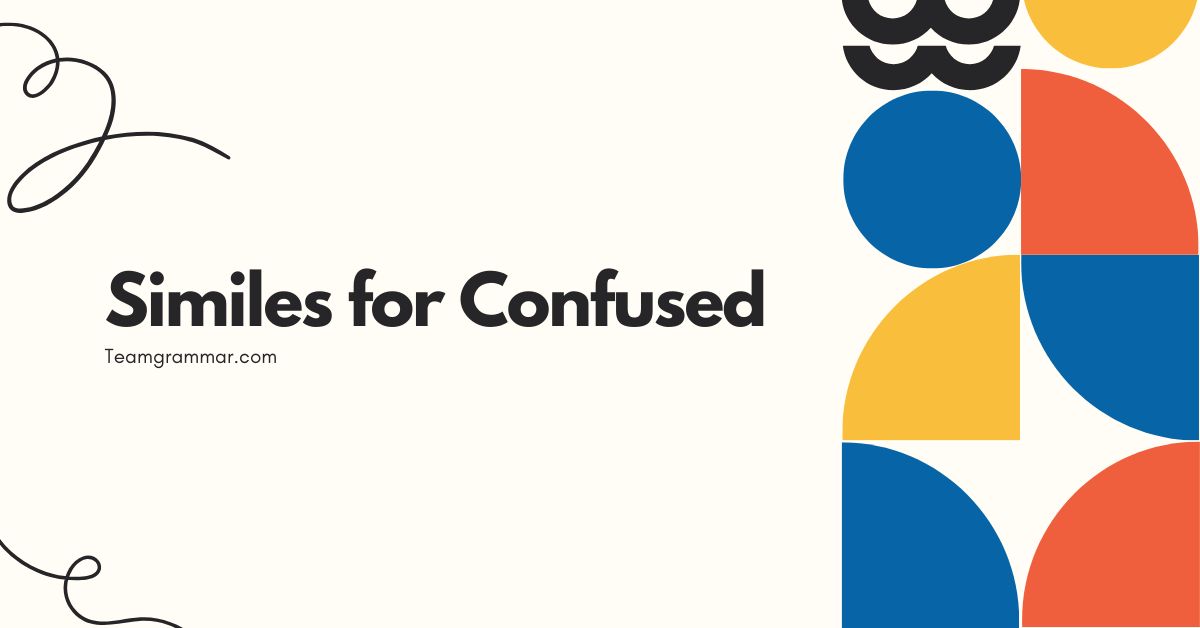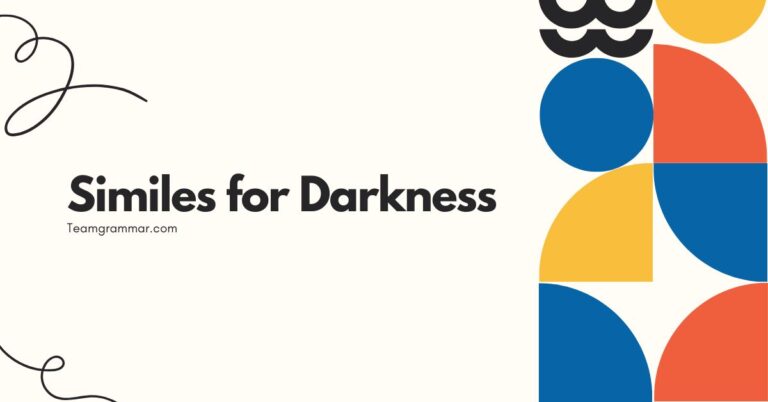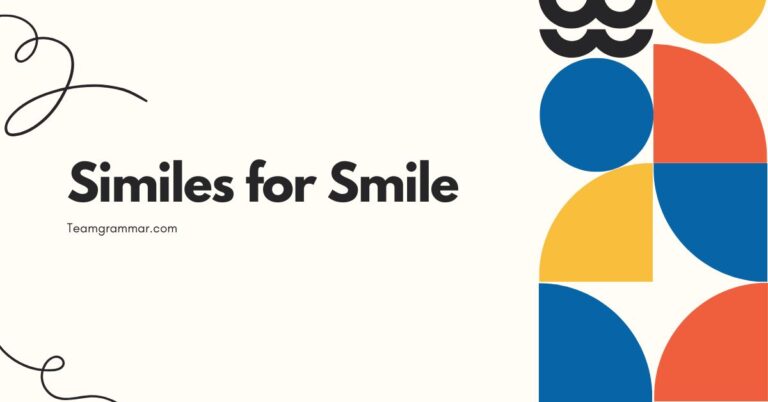31 Similes for Confused: Understanding Comparisons in English
Understanding similes is crucial for mastering figurative language and enriching your expressive abilities in English. Similes, a fundamental element of rhetoric and literary devices, allow you to draw vivid comparisons between seemingly unrelated things, adding depth and color to your writing and speech.
This article provides a comprehensive guide to similes, exploring their structure, types, and usage, making it an invaluable resource for students, writers, and anyone looking to enhance their language skills. Whether you’re a beginner or an advanced learner, this guide will equip you with the knowledge and practice to effectively use similes and recognize them in various contexts.
Table of Contents
- Definition of Similes
- Structural Breakdown of Similes
- Types and Categories of Similes
- Examples of Similes
- Usage Rules for Similes
- Common Mistakes with Similes
- Practice Exercises
- Advanced Topics in Similes
- Frequently Asked Questions (FAQ)
- Conclusion
Definition of Similes
A simile is a figure of speech that directly compares two different things using the words “like” or “as.” The purpose of a simile is to illustrate a similarity or shared quality between the two subjects being compared, making the description more vivid and relatable. Similes are essential tools for writers and speakers aiming to create imagery, evoke emotions, and clarify complex ideas through familiar comparisons.
Unlike metaphors, which imply a direct equivalence, similes acknowledge that the two subjects are distinct entities. The use of “like” or “as” explicitly signals the comparison.
Similes function as a type of figurative language, meaning they deviate from the literal meanings of the words involved to achieve a specific rhetorical effect. They help to paint a clearer picture in the reader’s or listener’s mind by associating an unfamiliar concept with something more familiar.
In essence, similes serve as bridges, connecting abstract ideas to concrete experiences. The effectiveness of a simile depends on the aptness of the comparison and its ability to resonate with the audience.
A well-crafted simile can transform ordinary descriptions into memorable and impactful statements.
In different contexts, similes can serve various purposes. In literature, they contribute to the overall aesthetic and thematic depth of the text.
In everyday conversation, they can simplify explanations and add color to descriptions. In persuasive writing, similes can make arguments more compelling by drawing parallels that resonate with the audience’s values and beliefs.
Understanding the function of similes is crucial for both interpreting and creating effective communication. By recognizing and utilizing similes, individuals can significantly enhance their ability to express themselves clearly and creatively.
Structural Breakdown of Similes
The basic structure of a simile involves three key components: the subject being described, the word “like” or “as,” and the object or idea to which the subject is being compared. This straightforward structure allows for a wide range of creative expressions.
Understanding each component is essential for constructing effective and meaningful similes. The careful selection of the object of comparison is crucial in determining the impact and clarity of the simile.
The subject is the entity or concept that is being described. It can be a person, place, thing, or idea.
The choice of subject depends on the context and the message the speaker or writer wants to convey. The subject is often the focal point of the description, and the simile serves to enhance the understanding or appreciation of this subject.
For example, in the simile “Her smile was like sunshine,” the subject is “Her smile.”
The words “like” and “as” serve as the connective tissue of the simile, explicitly indicating that a comparison is being made. While both words can be used interchangeably in many cases, there are subtle differences in their usage.
“Like” is often used to compare nouns or pronouns, while “as” can be used in more complex comparisons involving clauses or phrases. For example, “He runs like the wind” uses “like” to compare his running to the wind, while “She sings as beautifully as an angel” uses “as” to compare her singing to that of an angel.
The object of comparison is the entity or idea to which the subject is being likened. This object should share a quality or characteristic with the subject that is relevant to the intended meaning of the simile.
The selection of the object of comparison is crucial for creating a vivid and impactful simile. It should be something that the audience can easily relate to and understand.
For instance, in the simile “The snow was as white as cotton,” the object of comparison is “cotton,” which is commonly associated with whiteness.
Consider these examples illustrating the structural components:
- Subject: The baby’s skin Connector: was like Object of Comparison: silk.
- Subject: His anger Connector: was as Object of Comparison: a raging storm.
- Subject: The city Connector: is like Object of Comparison: a jungle.
Types and Categories of Similes
Similes can be categorized based on their function and the type of comparison they make. Understanding these categories can help you identify and create more effective similes.
Some common categories include descriptive similes, explanatory similes, and emphatic similes. Each type serves a distinct purpose in enhancing communication.
Descriptive Similes
Descriptive similes aim to paint a vivid picture of the subject by comparing it to something with well-known qualities. These similes often appeal to the senses, creating a richer and more immersive experience for the reader or listener.
The effectiveness of a descriptive simile lies in its ability to evoke a strong sensory image.
For example, “The sunset was like a fiery painting” uses the image of a “fiery painting” to convey the vibrant colors and dramatic beauty of the sunset. Similarly, “Her voice was as smooth as velvet” uses the tactile quality of “velvet” to describe the pleasant texture of her voice.
These similes enhance the reader’s understanding and appreciation of the subject by appealing to their senses.
Explanatory Similes
Explanatory similes are used to clarify or explain a concept by comparing it to something more familiar or easily understood. These similes are particularly useful when dealing with abstract or complex ideas.
The goal is to make the unfamiliar more accessible by relating it to something the audience already knows.
For instance, “The process is like assembling a puzzle” uses the familiar task of assembling a puzzle to explain a complex process, breaking it down into manageable steps. “Understanding quantum physics is like trying to catch smoke with your bare hands” illustrates the elusive and challenging nature of quantum physics.
These similes aid comprehension by drawing parallels to common experiences.
Emphatic Similes
Emphatic similes are used to emphasize a particular quality or characteristic of the subject, often to create a stronger emotional impact. These similes are designed to highlight the intensity or significance of the subject’s attributes.
They serve to amplify the message and leave a lasting impression on the audience.
For example, “He was as stubborn as a mule” emphasizes his unyielding nature, using the well-known stubbornness of mules as a comparison. “Her love was like a burning fire” highlights the intensity and passion of her love.
These similes add emotional depth and forcefulness to the description, making it more memorable and impactful.
Examples of Similes
The best way to understand similes is by examining a variety of examples. The following tables provide numerous examples of similes, categorized by the quality or characteristic being emphasized.
These examples illustrate the versatility and effectiveness of similes in enhancing communication. By studying these examples, you can gain a deeper understanding of how to create and use similes effectively.
Similes Describing Appearance
This table provides examples of similes used to describe the appearance of various subjects. These similes often focus on visual qualities such as color, shape, and texture, enhancing the reader’s ability to visualize the subject.
| Simile | Explanation |
|---|---|
| Her hair was like spun gold. | Compares the color and texture of her hair to the precious metal gold. |
| His eyes were as blue as the summer sky. | Compares the color of his eyes to the clear blue of the sky. |
| The snow was like a white blanket. | Compares the appearance of the snow to a smooth, covering blanket. |
| The moon was as round as a silver dollar. | Compares the shape of the moon to a perfectly round coin. |
| Her skin was like porcelain. | Compares the smoothness and delicate quality of her skin to porcelain. |
| His beard was like a tangled bush. | Compares the unkempt appearance of his beard to a wild bush. |
| The dress was as red as a ruby. | Compares the color of the dress to the deep red of a ruby. |
| Her teeth were like pearls. | Compares the color and shine of her teeth to precious pearls. |
| The lake was as clear as glass. | Compares the transparency of the lake to clear glass. |
| His face was like a weathered map. | Compares the lines and wrinkles on his face to the lines on a map. |
| The clouds were like cotton candy. | Compares the fluffy appearance of the clouds to sweet cotton candy. |
| Her smile was as bright as the sun. | Compares the radiance of her smile to the sun’s brightness. |
| The mountains were like sleeping giants. | Compares the massive and still appearance of the mountains to giants. |
| His voice was as deep as the ocean. | Compares the depth and resonance of his voice to the ocean. |
| The leaves were like emeralds. | Compares the color and shimmer of the leaves to precious emeralds. |
| Her laughter was as light as a feather. | Compares the airy quality of her laughter to a feather. |
| The building was like a concrete jungle. | Compares the density and harshness of the building to a jungle. |
| His eyes were as cold as ice. | Compares the emotionless look in his eyes to the coldness of ice. |
| The flowers were like a rainbow. | Compares the variety of colors in the flowers to a rainbow. |
| Her touch was as soft as a butterfly’s wing. | Compares the gentle quality of her touch to a butterfly’s wing. |
| The city at night was like a sea of stars. | Compares the twinkling lights of the city to the stars in the sky. |
| His hair was as black as night. | Compares the color of his hair to the darkness of night. |
| The sand was like powdered sugar. | Compares the fine texture of the sand to powdered sugar. |
Similes Describing Behavior
This table showcases similes that describe the behavior or actions of individuals or entities. These similes often highlight specific traits or habits, providing insight into the subject’s character or demeanor.
| Simile | Explanation |
|---|---|
| He eats like a horse. | Compares his large appetite to that of a horse. |
| She sings like an angel. | Compares her beautiful singing to the angelic quality of an angel’s voice. |
| They fight like cats and dogs. | Compares their frequent and intense arguments to the constant bickering of cats and dogs. |
| He works like a machine. | Compares his tireless work ethic to the relentless operation of a machine. |
| She sleeps like a log. | Compares her deep and undisturbed sleep to the stillness of a log. |
| He runs like the wind. | Compares his speed to the swiftness of the wind. |
| She swims like a fish. | Compares her natural swimming ability to the ease of a fish in water. |
| They argue like lawyers. | Compares their skillful and persuasive arguments to those of lawyers. |
| He dances like a puppet on strings. | Compares his awkward and controlled movements to a puppet’s motions. |
| She gossips like a magpie. | Compares her talkative nature to the chattering of a magpie. |
| He follows like a shadow. | Compares his constant presence to the unwavering nature of a shadow. |
| She leads like a general. | Compares her strong leadership skills to the command of a general. |
| He drinks like a fish. | Compares his excessive drinking to the way a fish constantly takes in water. |
| She cries like a baby. | Compares her loud and unrestrained crying to that of a baby. |
| He laughs like a hyena. | Compares his harsh and unsettling laughter to the sound of a hyena. |
| She worries like a mother hen. | Compares her excessive worrying to the protective nature of a mother hen. |
| He sneaks like a fox. | Compares his sly and stealthy movements to those of a fox. |
| She observes like a hawk. | Compares her sharp and attentive observation skills to those of a hawk. |
| He plans like a strategist. | Compares his careful and calculated planning to that of a strategist. |
| She adapts like a chameleon. | Compares her ability to adjust to new situations to the adaptability of a chameleon. |
| He complains like a broken record. | Compares his repetitive complaints to a skipping record. |
| She remembers like an elephant. | Compares her excellent memory to the proverbial memory of an elephant. |
| He ignores like a stone wall. | Compares his lack of response to the impassivity of a stone wall. |
Similes Describing Feelings or Emotions
This table presents similes used to describe feelings or emotions. These similes often draw on sensory experiences or relatable situations to convey the intensity and nuances of various emotions.
| Simile | Explanation |
|---|---|
| His heart felt like a lead weight. | Compares the heaviness of his sadness to the weight of lead. |
| She was as happy as a clam. | Compares her extreme happiness to the supposed contentment of a clam. |
| He felt like a fish out of water. | Compares his discomfort and unease to the feeling of a fish out of water. |
| She was as nervous as a long-tailed cat in a room full of rocking chairs. | Compares her anxiety to the precarious situation of a cat in a room with rocking chairs. |
| He was as angry as a hornet. | Compares his intense anger to the aggressive nature of a hornet. |
| She felt like she was walking on air. | Compares her feeling of lightness and joy to walking on air. |
| He was as lonely as a cloud. | Compares his solitude to the isolation of a single cloud in the sky. |
| She felt like a caged bird. | Compares her sense of confinement to the restricted life of a caged bird. |
| He was as excited as a kid in a candy store. | Compares his enthusiasm to the excitement of a child in a candy store. |
| She felt like she had been hit by a truck. | Compares her feeling of exhaustion and overwhelm to being struck by a truck. |
| He was as brave as a lion. | Compares his courage to the bravery associated with a lion. |
| She felt like she was drowning in sorrow. | Compares her overwhelming sadness to the sensation of drowning. |
| He was as calm as a still pond. | Compares his tranquility to the peacefulness of a still pond. |
| She felt like she was on top of the world. | Compares her feeling of triumph and success to being at the highest point. |
| He was as stubborn as a mule. | Compares his unyielding nature to the stubbornness of a mule. |
| She felt like she was carrying the weight of the world on her shoulders. | Compares her sense of responsibility and burden to carrying the world’s weight. |
| He was as proud as a peacock. | Compares his vanity to the ostentatious display of a peacock. |
| She felt like she was lost in a maze. | Compares her confusion and uncertainty to being lost in a maze. |
| He was as patient as a saint. | Compares his tolerance and forbearance to the patience of a saint. |
| She felt like she was walking through a dream. | Compares her sense of unreality and detachment to being in a dream. |
| He was as quiet as a mouse. | Compares his silence to the quietness of a mouse. |
| She felt like she was watching a train wreck. | Compares her feeling of helplessness to witnessing a disaster. |
| He was as gentle as a lamb. | Compares his kindness to the gentleness of a lamb. |
Usage Rules for Similes
Using similes effectively requires adherence to certain rules to ensure clarity and impact. These rules govern the choice of comparison, the consistency of tone, and the avoidance of clichés.
By following these guidelines, you can create similes that enhance your writing and speaking.
Choose Relevant Comparisons:The most important rule is to select a comparison that is relevant to the subject being described. The object of comparison should share a quality or characteristic with the subject that is meaningful and contributes to the overall message.
Irrelevant or nonsensical comparisons can confuse the audience and undermine the effectiveness of the simile.
Maintain Consistency of Tone:The tone of the simile should be consistent with the overall tone of the writing or speech. A simile that is too humorous or informal may be inappropriate in a serious or formal context, and vice versa.
Consider the audience and the purpose of the communication when choosing a simile.
Avoid Clichés:Clichéd similes, such as “as busy as a bee” or “as strong as an ox,” have become overused and lack originality. While they may be easily understood, they often fail to create a fresh or impactful image.
Strive to create original similes that offer a unique perspective.
Ensure Clarity:The simile should be clear and easy to understand. Avoid obscure or overly complex comparisons that may confuse the audience.
The object of comparison should be familiar to the audience, or the simile should provide enough context to make the comparison clear.
Use Sparingly:While similes can enhance writing and speaking, overuse can diminish their impact. Use similes judiciously, reserving them for situations where they can make a significant contribution to the message.
Too many similes can make the writing feel cluttered and artificial.
Common Mistakes with Similes
Even experienced writers and speakers can make mistakes when using similes. Recognizing these common errors can help you avoid them and improve the effectiveness of your similes.
These mistakes often involve misuse of “like” and “as,” illogical comparisons, and overuse of clichés.
Misusing “Like” and “As”: One common mistake is using “like” as a conjunction instead of “as.” “Like” should be used to introduce a simile, while “as” should be used to introduce a clause. For example, “He runs like the wind” is correct, but “He runs like he is the wind” is incorrect and should be “He runs as if he is the wind.”
Illogical Comparisons:Avoid making comparisons that are illogical or nonsensical. The object of comparison should share a relevant quality or characteristic with the subject.
Comparing unrelated things can confuse the audience and undermine the effectiveness of the simile. For example, “The car was like a banana” is an illogical comparison because cars and bananas share no meaningful similarities.
Overusing Clichés:As mentioned earlier, using clichéd similes can make your writing sound unoriginal and uninspired. While clichés may be easily understood, they often fail to create a fresh or impactful image.
Strive to create original similes that offer a unique perspective. Instead of saying “as busy as a bee,” try “as swamped as a short-order cook at lunchtime.”
Lack of Clarity:A simile should be clear and easy to understand. Avoid obscure or overly complex comparisons that may confuse the audience.
The object of comparison should be familiar to the audience, or the simile should provide enough context to make the comparison clear. For example, if you are comparing something to a “quincunx,” you should explain what a quincunx is, or choose a more familiar comparison.
The table below shows common mistakes and their corrections:
| Incorrect | Correct | Explanation |
|---|---|---|
| He sings like an angel does. | He sings as an angel does. | “As” should be used to introduce a clause. |
| The building was like a fish. | The building was like a towering skyscraper. | The comparison should be logical and relevant. |
| She was as busy as a bee. | She was as swamped as a short-order cook at lunchtime. | Avoid clichés and strive for originality. |
| The concept was like a quantum entanglement. | The concept was like a complex knot. | Ensure the comparison is clear and understandable to the audience. |
Practice Exercises
Test your understanding of similes with these practice exercises. Each exercise focuses on different aspects of simile usage, from identifying similes to creating your own.
These exercises will help you reinforce your knowledge and improve your ability to use similes effectively.
Exercise 1: Identifying Similes
Identify the similes in the following sentences.
| Question | Answer |
|---|---|
| 1. The clouds were like fluffy cotton balls in the sky. | like fluffy cotton balls |
| 2. He ran as fast as a cheetah. | as fast as a cheetah |
| 3. Her voice was smooth and melodic. | (No simile) |
| 4. The night was as dark as ink. | as dark as ink |
| 5. The children played happily in the park. | (No simile) |
| 6. The old house stood like a forgotten sentinel. | like a forgotten sentinel |
| 7. His words were sharp and cutting. | (No simile) |
| 8. She was as graceful as a swan. | as graceful as a swan |
| 9. The city was bustling with activity. | (No simile) |
| 10. The secret was as safe as houses. | as safe as houses |
Exercise 2: Completing Similes
Complete the following similes with appropriate endings.
| Question | Answer |
|---|---|
| 1. His temper was as explosive as _____. | a volcano |
| 2. She was as quiet as _____. | a mouse |
| 3. The news hit him like _____. | a ton of bricks |
| 4. The fabric felt like _____. | silk |
| 5. The task was as easy as _____. | pie |
| 6. The rain fell like _____. | tears |
| 7. His smile was as warm as _____. | sunshine |
| 8. The room was as cold as _____. | ice |
| 9. The coffee tasted like _____. | mud |
| 10. The crowd roared like _____. | a lion |
Exercise 3: Creating Similes
Create similes to describe the following subjects.
| Subject | Possible Simile |
|---|---|
| 1. A crowded street | A crowded street is like a river of people flowing in different directions. |
| 2. A peaceful forest | A peaceful forest is like a sanctuary where nature’s symphony plays. |
| 3. A difficult challenge | A difficult challenge is like climbing a steep mountain with no clear path. |
| 4. A close friendship | A close friendship is like a sturdy bridge connecting two souls. |
| 5. A heartfelt apology | A heartfelt apology is like a balm that soothes a wounded heart. |
| 6. A vibrant painting | A vibrant painting is like a window into a world bursting with color and emotion. |
| 7. A catchy song | A catchy song is like a persistent earworm that you can’t stop humming. |
| 8. A gripping novel | A gripping novel is like a rollercoaster ride that keeps you on the edge of your seat. |
| 9. A star-filled night | A star-filled night is like a vast canvas dotted with diamonds. |
| 10. A gentle breeze | A gentle breeze is like a soft caress on your skin. |
Advanced Topics in Similes
For advanced learners, exploring more complex aspects of similes can further enhance their understanding and usage. These advanced topics include extended similes, the use of similes in poetry, and the cultural variations in simile usage.
Mastering these topics can elevate your command of figurative language.
Extended Similes:An extended simile is a simile that is developed over several lines or sentences, providing a more detailed and elaborate comparison. This technique allows for a deeper exploration of the similarities between the subject and the object of comparison, creating a more vivid and impactful image.
Extended similes are often used in poetry and prose to add depth and complexity to the writing.
Similes in Poetry:Poetry often makes extensive use of similes to create imagery, evoke emotions, and convey meaning. Poets carefully select similes to enhance the aesthetic and thematic qualities of their work.
The use of similes in poetry can range from simple comparisons to complex and metaphorical expressions.
Cultural Variations:The usage and interpretation of similes can vary across cultures. Some comparisons may be more relevant or meaningful in certain cultural contexts than others.
Understanding these cultural variations is important for effective communication and avoiding misunderstandings. For example, a simile that relies on a specific cultural reference may not be understood by someone from a different background.
Frequently Asked Questions (FAQ)
Here are some frequently asked questions about similes.
- What is the difference between a simile and a metaphor?
A simile explicitly compares two things using “like” or “as,” while a metaphor implies a direct equivalence without using those words. For example, “He is like a lion” is a simile, while “He is a lion” is a metaphor. Similes make a comparison, while metaphors assert an identity.
- Can a simile be a cliché?
Yes, similes can become clichés when they are overused and lose their originality. Examples like “as busy as a bee” or “as strong as an ox” are clichés. It’s best to avoid these and create fresh, unique comparisons.
- How do I create effective similes?
To create effective similes, choose relevant comparisons, maintain consistency of tone, avoid clichés, ensure clarity, and use them sparingly. The object of comparison should share a meaningful quality with the subject.
- What is the purpose of using similes?
Similes are used to create vivid imagery, evoke emotions, clarify complex ideas, and enhance the overall impact of writing or speaking. They help to make descriptions more relatable and memorable.
- Are similes only used in writing?
No, similes are used in both writing and speaking. They are a common tool for enhancing communication in various contexts, from literature to everyday conversation.
- How can I identify similes in a text?
Similes can be identified by the presence of the words “like” or “as” used to compare two different things. Look for phrases that explicitly draw a comparison between two subjects.
- Can a simile be extended over multiple sentences?
Yes, an extended simile is a simile that is developed over several lines or sentences, providing a more detailed and elaborate comparison. This technique allows for a deeper exploration of the similarities between the subject and the object of comparison.
- What should I do if I can’t think of a good simile?
If you’re struggling to come up with a good simile, try brainstorming different qualities or characteristics of the subject and then think of things that share those qualities. Consider sensory details, emotions, and relatable experiences.
- Is it okay to use similes in formal writing?
Yes, similes can be used in formal writing, but they should be used judiciously and with careful consideration of the audience and purpose. Ensure that the similes are appropriate for the tone and context of the writing.
- How do similes contribute to the overall quality of writing?
Similes contribute to the overall quality of writing by adding depth, color, and clarity to descriptions. They can make writing more engaging, memorable, and impactful, helping to convey complex ideas in a relatable way.
Conclusion
Similes are a powerful tool for enriching language and enhancing communication. By understanding their structure, types, and usage rules, you can effectively incorporate similes into your writing and speaking to create vivid imagery, evoke emotions, and clarify complex ideas.
Avoid common mistakes like misusing “like” and “as,” using illogical comparisons, and relying on clichés. Practice identifying and creating similes to reinforce your knowledge and improve your skills.
Remember that the key to using similes effectively is to choose relevant and original comparisons that resonate with your audience. Pay attention to the tone and context of your communication, and use similes sparingly to maximize their impact.
With practice and attention to detail, you can master the art of using similes to enhance your expressive abilities and communicate more effectively. By continuously practicing and refining your understanding, you can unlock the full potential of similes in your writing and speaking.







